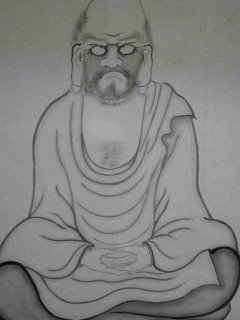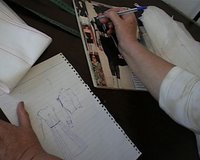SHADOW OF A FLOWER

Sign out: a chronological copy of all my Japan blogs is up at http://www.ralphhoyte.net/Japan/Japan_Trip.html with a few more pictures. No chance of getting a film ready for the Tate presentation next week, may just take one exemplary episode and run that in something pedestrian like Powerpoint (Powerpoint actually has very interesting artistic potential as just something you can embed all sorts of stuff in and fire off at will), front it live dressed in my Samu-e (samu=work, samu-e= workclothes; samurai, eg, means 'somone who serves' ie works for the lord; Buddhist monks wear a samu-e for work period ie for 'samu'; I bought one in Japan's 2nd largest department store, Tobu, in Ikebukuro, Tokyo)
going North
mountains rise above
the golf course
'TAKE FREE'
it says across a girl's boobs
hmm ... better not
some none-posted snippets:
You are advised to wear 'bear bells' if you're walking in bear country in Japan. The bears don't necessarily want to kill you, but as they're short-sighted you might stumble into one round a bend in the track before it sees you, so it'll be frightened and attack and kill you. The 'bear bells' give an audible warning of your approach, so it has time to run away.
Actually, the real reason is that when the bear hears the bells it thinks you're a 'henryo' - a wandering monk - so it rushes up to you, bows deeply, does 6 full prostrations, straightens up, yells 'nen pi kan non rikki' ('I evoke the Great Defender's Mercy') and vanishes into the bushes...
fading hours of Hachiman Matsuri in Takayama
street vendors 'special offer'
chocolate bananas
teenage totty lights up the strip
hanging out on the street corners
paper blowing in the wind
a lone drunk snores on the river bank
look! a Koi carp
a heron investigates
"The building has the 4 floors but 7 layers and we are on the 2nd floor but on the 4th layer. In the Edo Period the Tokugawa shogunate strictly prohibited us from constructing buildings which had more than 3 floors. That is why the stairs which led to the 3rd floor had to be concealed." (explanation in guide to Myoryuji - Myoryu Temple - in Kanazawa, otherwise known as 'Ninjadera' because it has many trapdoors, tunnels, false exits etc to foil attackers as a first line of defence for the old castle. Actually nothing to do with 'ninja')
Hida-no-Sato (Hida Folk Village) on the outskirts of Takayama has dozens of traditional farmhouses from Hida Province and nearby provinces which were demolished then reconstructed on this large, sloping site. They're all beautifully maintained but it doesn't have the air of 'a museum', rather that of a working community. You walk into eg The Arai's house and expect the wife of the house to get up and offer you tea and there's 'farm clutter' behind the houses. Partly because they each have a smoking log fire in the firepit - the information board says this is necessary to, a) kill wood-boring insects and b) keep the ropes used to tie the rafters on tight. Japanese houses of the era had a firepit in the middle of the main 'room', no chimney - the smoke just rose thru' the open laths of the non-existent 'ceiling' and filtered through the thatch. They were very dark (no 'windows' and, of course, smoky. Because it was very dark, the Japanese aesthetic of the era was one of 'shadows' - the glint of gold, for example. When such objects are put in bright light they may seem almost garish - but they were never seen or meant to be seen like this (cf 'In Praise of Shadows' by Jun'ichiro Tanizaki). The smoke gives the wood a beautiful dark sheen. The blurb for the village says: "Japan's economy has recently made very rapid progress but our material success has caused us to think too little about the important spiritual side of life. We now realize we should pay more attention to our cutural heritage our ancestors have built up for centuries. We must return to some of our traditional modes of living. Not only must we revalue and preserve our heritage, but we must hand it on to future generations. That is why we have established this reservation. The quite atmosphere of this place gives you a restful and peaceful feeling. Here, all things are well harmonized with nature."
I spend hours photographing wood, straw, thatch, a woman thatcher tying bundles of straw to rethatch the Nishioka's house; eat lunch and fall asleep in the sun on a piece of sheet metal next to the Michigami's house. Then wander down to the craft village, where a craftswoman in a smock is training two apprentice weavers. Wonderful to watch the seriousness with which the Japanese take what they do, this feeling of a strong, beautiful craft being passed on, not something fake 'just for the benefit of the tourists'. Wonderful to watch a strong, serious craftswoman, a master at her work.




